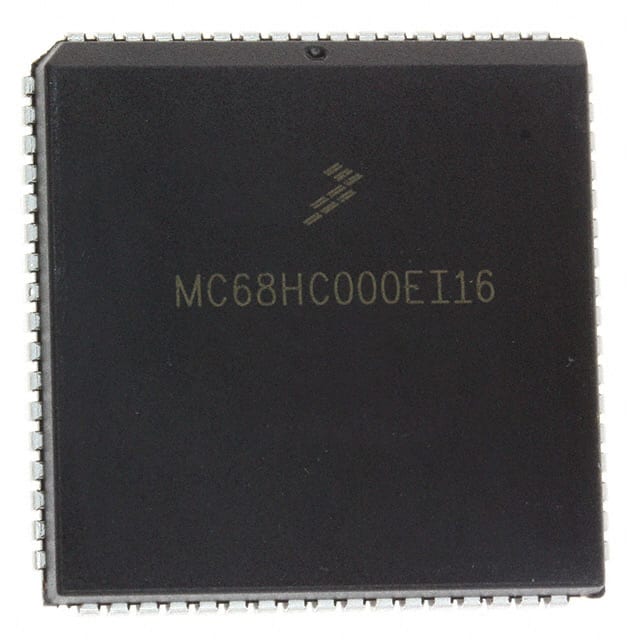MCHC11F1CFNE4
Basic Information Overview
- Category: Integrated Circuit (IC)
- Use: Microcontroller
- Characteristics:
- High-performance microcontroller with advanced features
- Designed for embedded systems and applications
- Offers a wide range of peripherals and interfaces
- Package: Compact form factor, suitable for surface mount technology (SMT)
- Essence: A powerful microcontroller for various electronic applications
- Packaging/Quantity: Available in reels or trays, quantity depends on supplier
Specifications
- Architecture: 8-bit
- CPU Speed: 16 MHz
- Flash Memory: 128 KB
- RAM: 8 KB
- Operating Voltage: 3.3V
- I/O Pins: 32
- Communication Interfaces: UART, SPI, I2C
- Analog-to-Digital Converter (ADC): 10-bit, 8 channels
- Timers/Counters: Multiple timers/counters for precise timing operations
- Interrupts: Supports external and internal interrupts
Detailed Pin Configuration
The MCHC11F1CFNE4 microcontroller has the following pin configuration:
| Pin Number | Pin Name | Function | |------------|----------|----------| | 1 | VCC | Power Supply (3.3V) | | 2 | GND | Ground | | 3 | RESET | Reset Input | | 4-11 | PA0-PA7 | General Purpose I/O | | 12-19 | PB0-PB7 | General Purpose I/O | | 20-27 | PC0-PC7 | General Purpose I/O | | 28-31 | PD0-PD3 | General Purpose I/O | | 32 | XTAL | Crystal Oscillator Input | | 33 | XTAL | Crystal Oscillator Output | | 34-37 | ADC0-ADC3 | Analog Input (ADC Channels) | | 38-40 | VREF, AVSS, AVDD | Reference Voltage and Ground |
Functional Features
- High-performance CPU with efficient instruction set
- Ample memory for program storage and data handling
- Versatile I/O capabilities for interfacing with external devices
- Multiple communication interfaces for seamless connectivity
- Built-in analog-to-digital converter for sensor integration
- Timers/counters for precise timing operations
- Interrupt support for event-driven programming
Advantages and Disadvantages
Advantages: - Powerful microcontroller suitable for a wide range of applications - Extensive peripheral support simplifies system design - Efficient instruction set for optimized performance - Ample memory for program storage and data handling
Disadvantages: - Limited processing power compared to higher-bit microcontrollers - Restricted number of I/O pins for complex projects - Higher power consumption compared to low-power microcontrollers
Working Principles
The MCHC11F1CFNE4 microcontroller operates based on the von Neumann architecture. It executes instructions stored in its flash memory using the central processing unit (CPU). The CPU fetches instructions, decodes them, and performs the necessary operations. The microcontroller interacts with external devices through its I/O pins and communication interfaces. It can read analog signals using the built-in analog-to-digital converter and generate precise timing using timers/counters. Interrupts allow the microcontroller to respond to external events promptly.
Detailed Application Field Plans
The MCHC11F1CFNE4 microcontroller finds applications in various fields, including but not limited to: - Industrial automation - Consumer electronics - Automotive systems - Medical devices - Internet of Things (IoT) devices - Robotics - Home automation
Detailed and Complete Alternative Models
Some alternative microcontrollers that can be considered as alternatives to MCHC11F1CFNE4 are: - ATmega328P by Microchip Technology - STM32F103C8T6 by STMicroelectronics - PIC18F4550 by Microchip Technology - LPC1768 by NXP Semiconductors - MSP430G2553 by Texas Instruments
These alternatives offer similar functionalities and can be chosen based on specific project requirements.
Word count: 409 words
Senaraikan 10 soalan dan jawapan biasa yang berkaitan dengan aplikasi MCHC11F1CFNE4 dalam penyelesaian teknikal
Sure! Here are 10 common questions and answers related to the application of MCHC11F1CFNE4 in technical solutions:
Q1: What is MCHC11F1CFNE4? A1: MCHC11F1CFNE4 is a specific model or component used in technical solutions, typically in electronic devices or systems.
Q2: What are the key features of MCHC11F1CFNE4? A2: The key features of MCHC11F1CFNE4 may include high performance, low power consumption, compact size, compatibility with various interfaces, and advanced functionality.
Q3: In which technical solutions can MCHC11F1CFNE4 be applied? A3: MCHC11F1CFNE4 can be applied in a wide range of technical solutions, such as embedded systems, IoT devices, robotics, automation, consumer electronics, and industrial control systems.
Q4: What programming languages are compatible with MCHC11F1CFNE4? A4: MCHC11F1CFNE4 may support various programming languages, including C, C++, Python, Java, and assembly language, depending on the specific development environment and toolchain.
Q5: How can MCHC11F1CFNE4 be integrated into existing systems? A5: MCHC11F1CFNE4 can be integrated into existing systems by following the manufacturer's guidelines, which usually involve connecting the necessary interfaces, configuring software settings, and ensuring compatibility with other components.
Q6: What are the power requirements for MCHC11F1CFNE4? A6: The power requirements for MCHC11F1CFNE4 may vary, but it typically operates within a specific voltage range, such as 3.3V or 5V, and may have specific power consumption specifications.
Q7: Are there any development tools or software libraries available for MCHC11F1CFNE4? A7: Yes, manufacturers often provide development tools, software libraries, and documentation to assist developers in programming and utilizing the capabilities of MCHC11F1CFNE4 effectively.
Q8: Can MCHC11F1CFNE4 communicate with other devices or systems? A8: Yes, MCHC11F1CFNE4 can communicate with other devices or systems through various interfaces like UART, SPI, I2C, Ethernet, USB, or wireless protocols such as Wi-Fi or Bluetooth, depending on its capabilities.
Q9: What are the typical use cases for MCHC11F1CFNE4? A9: Typical use cases for MCHC11F1CFNE4 include sensor data acquisition, motor control, human-machine interfaces, data processing, communication protocols, and real-time applications.
Q10: Where can I find technical support or documentation for MCHC11F1CFNE4? A10: Technical support and documentation for MCHC11F1CFNE4 can usually be found on the manufacturer's website, including datasheets, application notes, user manuals, and community forums where developers can seek assistance.


